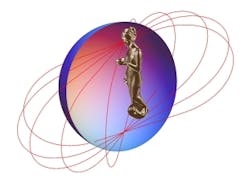Singapore--To understand what an imperfect invisible sphere would look like if viewed in the real world, Aaron Danner, an assistant professor at the National University of Singapore, wrote his own visualization software. (The invisibility sphere he modeled works perfectly for one polarization but not for the other.) Since then, just for fun, he has provided an image simulation made from a perspective inside a gradient-index lens called an inverted Eaton lens. In such a lens, the refractive index is 1 within the central spherical volume, while outside it varies continuously as a function of radius.
An ear for detail
Danner placed a simulated Greek statue within the central volume (see figure at top). The lens has the property of bending light back on itself to form a closed path. The resulting view the statue has is mostly a very distorted one of the back of her own head (with her ears especially prominent), although the cup she is holding is also visible (see figure below).
"What is interesting is that she would see the same view regardless of what direction she looks or of how big the room is," says Danner. "And although it's not really evident in the picture, the focal plane that her eye would perceive would only be a few inches from the front of her eye (the same distance that the back of her head is from her eyes)."
Danner says that this simulation makes use of similar rendering processes that he used to create the polarization-dependent invisible sphere, only this time the observer is inside looking out. The gradient-index lens was originally designed by: [J. C. Miñano, "Perfect imaging in a homogeneous threedimensional region," Opt. Express 14(21), 9627-9635 (2006)]. However, Danner notes that he actually got the design of the refractive index profile originally from Tomas Tyc at Masaryk University in the Czech Republic, who had designed it without knowing of Miñano's work.
About the Author
John Wallace
Senior Technical Editor (1998-2022)
John Wallace was with Laser Focus World for nearly 25 years, retiring in late June 2022. He obtained a bachelor's degree in mechanical engineering and physics at Rutgers University and a master's in optical engineering at the University of Rochester. Before becoming an editor, John worked as an engineer at RCA, Exxon, Eastman Kodak, and GCA Corporation.

